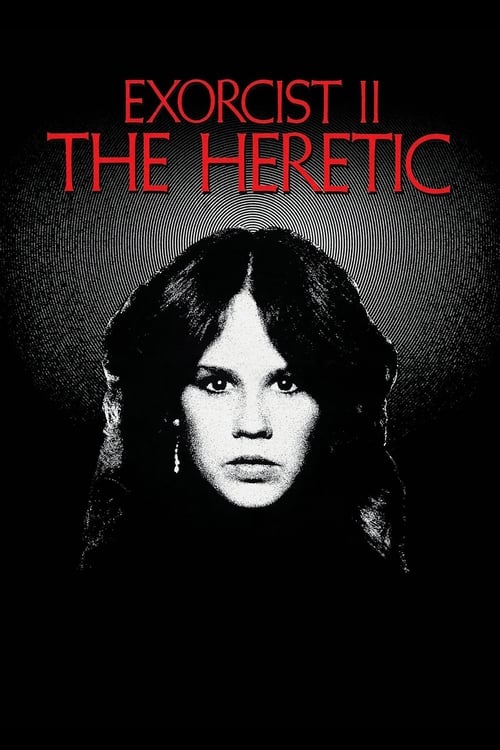Exorcist II: The Heretic – Film Review
Published September 3, 2023

Owing to his experience with exorcisms, Father Lamont is chosen by his superiors to investigate the death of Father Merrin, who died during the exorcism of young Regan MacNeil. Lamont finds Regan under the psychiatric care of Dr. Tuskin. By hypnotizing the girl, he is able to learn that Merrin previously exorcised the same demon from a boy in Africa. Hoping for answers, Lamont travels to Africa in search of the youth.
Exorcist II: The Heretic, directed by John Boorman, is a perplexing and often frustrating sequel to William Friedkin‘s iconic 1973 horror masterpiece, The Exorcist. While it’s not entirely devoid of merit, this film ultimately falls short of its predecessor in almost every way. With a disjointed plot, questionable character decisions, and a series of baffling creative choices, Exorcist II: The Heretic is a prime example of a sequel that fails to capture the magic of the original.
One of the most significant issues with this film is its narrative, which seems to be grasping at straws for a coherent storyline. The movie picks up several years after the events of the first film and introduces us to a grown-up Regan MacNeil (played by Linda Blair), who is now undergoing therapy with the enigmatic psychiatrist Dr. Gene Tuskin (played by Louise Fletcher). The central premise revolves around the idea of tapping into Regan’s subconscious to confront the evil force that possessed her in the past, a notion that feels more like an excuse to resurrect the demon Pazuzu rather than a well-thought-out plot point.
The film also introduces Father Lamont (played by Richard Burton), a priest sent by the Vatican to investigate the death of Father Merrin (played by Max von Sydow), the exorcist from the first film. While Burton’s performance is decent, his character’s motivations and actions are often baffling and inconsistent. At times, he’s a devout priest determined to eradicate evil, while at others, he seems more interested in pursuing a romantic relationship with Regan. These inconsistencies in character development make it difficult for the audience to connect with or care about the protagonists.
Moreover, Exorcist II: The Heretic suffers from a meandering and disjointed plot that jumps between various locations and timelines without clear transitions. The film frequently resorts to dream sequences and flashbacks, which only serve to confuse the viewer further. It’s as if Boorman attempted to craft a psychological thriller but ended up with a mishmash of disconnected scenes and ideas.
One of the most glaring issues with the film is the misguided attempt to explore the psychological aspects of evil and possession. While the original Exorcist was praised for its terrifying and realistic depiction of demonic possession, Exorcist II leans heavily on pseudoscientific mumbo-jumbo, including a laughably absurd “synchronizer” device that connects Regan’s mind with Lamont’s. These scenes come across as more comical than thought-provoking and undermine the film’s credibility as a horror movie.
Furthermore, the film’s visuals are a mixed bag. On one hand, there are some visually striking moments, such as the dream sequences that take place in a barren desert landscape. These scenes effectively convey a sense of isolation and unease. However, other visual choices, such as the use of excessive slow-motion and bizarre editing, make certain sequences feel unintentionally funny and disjointed.
The special effects, while ambitious for their time, have not aged well. The scenes involving the possessed locusts, which are meant to be a manifestation of evil, are more likely to induce laughter than fear. In comparison to the practical effects and makeup work in the original Exorcist, the sequel’s reliance on dated visual effects detracts from the overall horror experience.
In terms of performances, Linda Blair reprises her role as Regan MacNeil, but the character feels underutilized. Regan’s trauma and psychological journey should have been central to the film, but the disjointed plot sidelines her character in favor of Father Lamont’s baffling quest. Richard Burton, while a talented actor, seems disinterested in his role, and his performance lacks the gravitas needed to make his character compelling.
The film’s supporting cast, including Louise Fletcher and Max von Sydow, delivers serviceable performances, but they are hampered by a lackluster script that fails to explore their characters in depth. Von Sydow, in particular, deserved better material after his memorable performance as Father Merrin in the original film.
Another glaring issue with Exorcist II: The Heretic is its pacing. At a runtime of over two hours, the film often feels like a tedious slog. The lack of a cohesive narrative and the overuse of dream sequences and slow-motion sequences contribute to a sense of frustration as the audience waits for something meaningful to happen.
Exorcist II: The Heretic is a disappointing and disjointed sequel that fails to capture the essence of its predecessor. John Boorman’s attempt to delve into the psychological aspects of evil and possession results in a convoluted and confusing narrative, while the misguided use of visual effects and editing choices undermines the horror elements. Despite a few visually striking moments and decent performances from the cast, this film ultimately falls flat. It’s a prime example of a sequel that should have been left untouched, as it tarnishes the legacy of the original Exorcist. While it may hold some curiosity value for die-hard fans of the franchise, it’s not a film that will satisfy those seeking a worthy follow-up to one of the greatest horror films of all time.
